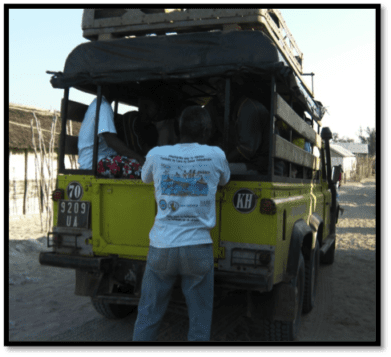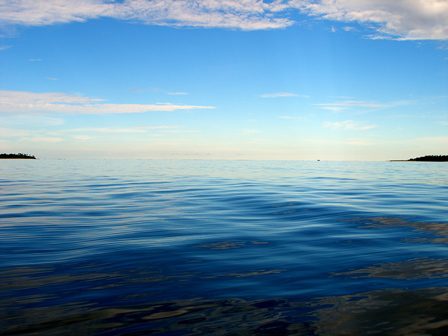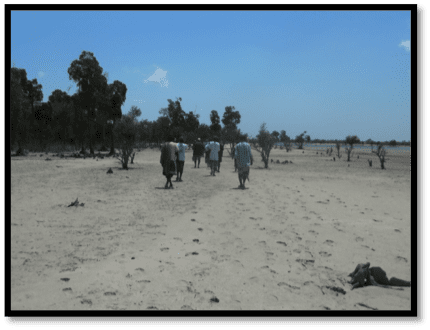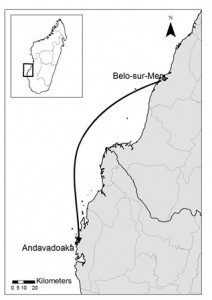I feared a revolt as I brought our group of weary travelers together at dusk, and told them that we’d be having our first evening session with the Velondriake Association committee members that very night. The response from the 16 exhausted faces looking back at me came without hesitation, “Of course, after all, this is what we came all this way for”.
Their trip hasn’t been easy. Two days and two hundred kilometers of bouncing over the dusty, rocky bush roads of western Madagascar, with the only respite being a restless night of “sleep” on the cement floor of the primary school in Manja, which, upon entry, strikes the visitor immediately as being a better designed solar oven than a place of higher learning. Our means of transport is a bright yellow Land Rover which has had the bed extended and a second axle added- a 6×6, if you will. Into this Frankenstein of a vehicle, we’ve managed to cram 24 people, and 2 large speakers blaring the same six songs (yes, Shakira’s WakaWaka World Cup song was a prominent member of this abbreviated playlist) for the duration of the trip.
After an early morning start in the inland town of Manja, and an excruciatingly long mid-day wait for the barge to cross the Mangoky River, we arrived in Andavadoaka just before dusk. Following my aforementioned briefing, exchange trip participants and Velondriake Association members scrambled up the hill to the “Nosy Cao” classroom, overlooking the village. Silence fell over the group, broken occasionally by the sounds of the fishing village at the bottom of the hill coming back to life after the mid-day siesta and the plucking away at computer keyboards of Blue Ventures volunteers and local staff, diligently entering data as the sun dipped further into the Mozambique Channel. Roger, president of the Velondriake fishermen association, began the traditional speeches welcoming the guests, followed by the president of the village, Monsieur Eugene, and the elder of Andavadoaka, Nahoda Noely. Finally, as the unofficial leader of our delegation, I wiped my dust streaked face and proceeded to bumble through what was I fear a fairly jangled off-the-cuff speech… Approving smiles from the audience reinforced what I’ve learned during my past 4 years of trying to master the Malagasy language- perfection matters not, just swallow your pride and let fly.

Velondriake Committee member Nahoda Marcel, from Bevato, chats with exchange trip participants from Belo-sur-Mer before departing for mangrove reserve visit
So why have I dragged these poor fishermen/women from their peaceful homes, in idyllic western Madagascar village of Belo-sur-Mer and Andranompasy, down some of the worst desert roads in the country to go from one remote fishing village to another equally remote fishing village? It’s because there’s something special going on in Andavadoaka and the 24 surrounding villages which are home to the Velondriake Association and their marine protected area: True community-based management, as never seen before in the Indian Ocean, empowering traditional fishing communities to sustainably manage the marine and coastal resources upon which they completely depend. More importantly, it’s the realization that this special something can not be communicated via stories, pictures, and radio emissions, but needs to be experienced first-hand, fisherman-to-fisherman (or woman), communicating in a way that only those who have spent their lives in a common struggle to live off the sea are able. A sort of secret language and handshake that us foreign NGO workers will never be able master.

Community- based management- empowering traditional fishing communities to sustainably manage the marine and coastal resources upon which they completely depend
I’ve spent the last year working for Blue Ventures in Belo-sur-Mer, beginning the first steps of disussions with local communities about marine conservation in the region, following models that have been developed over the past 5 years by Velondriake, some 200km further south, in partnership with Blue Ventures. In preparation for this trip, following community meetings where villagers in Belo and Andranompasy hand-picked their representatives, I’d exhorted the exchange trip participants to question everything they see, and not to hesitate to ask the most critical and difficult questions they can think of. Essentially, to challenge the Velondriake Association to see if they are the real deal, or if they’re a bunch of phonies backed by a Vazaha (western) NGO who’s just putting lipstick on a donkey. Many of the members of the Belo-sur-Mer community have already heard of the work of Velondriake on the radio, and embrace a healthy skepticism, as they’ve seen the results, or lack thereof, of years of other “development” projects that have come and gone in their home villages. Meaningless associations set up to get the latest handout from the seemingly never-ending development train. Can this one really be so different?
If I could pick a point where the group turned, I would say it was when Redoko, the president of the tiny Velondriake village of Ankindranoke, nestled deep in the mangroves, explained the titike, or traditional blessing, that had been made prior to the closure and subsequent opening of their temporary mangrove reserve. Redoko talked at length, describing the successive village meetings where opening dates were discussed and decided upon by the village, and the sharing of fishing gear, so that all members of the village could share equally in the bountiful harvest on the day of the reserve opening. As Redoko talked on I could see it hit home, the proverbial light bulbs switching on over participants’ heads. This was truly village-based management, and not the usual top-down, imposed restrictions that people were used to.

Participants cross a mud-flat to visit the permanent mangrove reserve in Vatoavo
The energy amongst the passengers in the yellow Frankenstein on our trip back to Andavadoaka following the mangrove reserves visit was electric. Shakira’s waka-wakaing was mercifully drowned out by animated discussions of where they would establish temporary reserves in Belo. Which mangrove area was the best? How long should it be closed for? How would they convince the rest of the community in Belo that this is a good thing? Ideas bubbled over as we careened our way up the sand track, overgrown with the ubiquitous spiny octopus tree, characteristic of the arid southwest of Madagascar.
The rest of the trip went perfectly to plan. A morning visit to the permanent coral reef reserve southeast of the island of Nosy Hao (now southern Madagascar’s most famous dive site for tourists – the spectacular recruitment reef complex), followed by a visit to a community-run seaweed farming site. Finally a wrap-up afternoon question and answer session with members of the Velondriake Association.
Roger and other members of the Velondriake Association made sure to temper the enthusiasm of the participants with a dose of reality, recounting how it took over 5 years to gain enough community support to establish the permanent reserve that we had visited that morning.
“There will be members of the community who resist. If you go at these people aggressively, argue and fight with them, or ignore their opinions and marginalize them, you will only make them resist you more tenaciously. Approach them, talk to them. If they do not agree with you today, talk to them again tomorrow, and the next day. Eventually you will win them over.”
Words of wisdom taken home by the exchange trip participants as they prepare to embark on their own journey of community-based management in their own villages.
Hopefully they choose a better soundtrack than that of the yellow 6×6.


